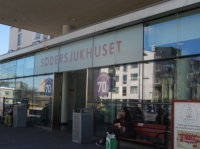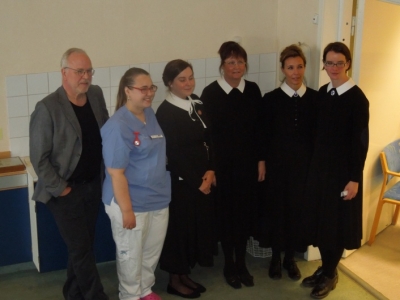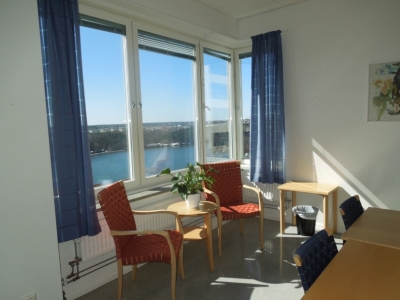Comprehensive, informative tour of Sweden’s iconic hospital

On the final day of the EAUN Congress in Stockholm last April, I had the opportunity to visit the Stockholm’s Södersjukhuset Hospital. While waiting, I became acquainted with the other participants and I was impressed by the attendance of various nationalities coming from Germany, The Netherlands, New Zealand to as far as China.
At the hospital’s reception area reception, we were all pleasantly surprised since it seemed as though we had stepped out of the time machine of Professor Barabas and came directly in contact with nurses from the era of Florence Nightingale.
There was a perfectly rational explanation to the old-fashioned tableau that we encountered. The hospital has been celebrating in the last few weeks its 70th foundation anniversary with several festive activities. The day we visited, the staff nurses were all dressed in period costumes or uniforms.
The Managing Director, Prof. Norming , welcomed us and briefly outlined the history of the hospital, its development over the years and the current challenges it faces. The hospital was founded by Hjalmar Cederström (° 1880 + 1953), and at that time the hospital’s establishment was considered a milestone in the Scandinavian medical history since it was the region’s first modern hospital.
Located in a hilly and green environment, the hospital was a witness to bloody executions during World War II. Today, the hospital has somehow lost its picturesque character and is now part of a complex of modern buildings built nearby. In 1944 there were 550,000 inhabitants in Stockholm, and at that time the average stay in a surgical ward was around 16 days, and 20 days for an internal department.
Nowadays, metropolitan Stockholm has around 1.4 million (urban area) to 2.2 million inhabitants (metropolitan area). The current and average hospital stay is around 4 days for surgery and 3.6 days for internal! The bed capacity expanded from 600 in 1944 to 1,410 in 1984. Nowadays, the trend is to shorten the hospital stay and the hospital now has about 650 beds to evolve in the future to 750 beds.
In bygone eras, the buildings were also not spacious enough for modern equipment, and the corridors were so narrow that it required some changes and thorough renovations. The alterations in recent years gave the complex a totally different look and due to the fact that the hospital stands on a hill, and is equipped with panoramic, glass windows with roomy terraces, it offers patients and visitors a wonderful view from their rooms.
Since the mid-1960s, the hospital plays an important role with regards to the education of nurses and doctors, and with added emphasis on medical research. After the briefing, we had a tour of the hospital’s Urology Department, operation rooms and Outpatient Clinic of Urology.
Urology department
The Department of Urology, which was founded in the mid-60s, currently has 23 beds and a range of flexible beds in other departments. On week days, the department is often fully occupied. The department is staffed by 20 full-time nurses and 10 nursing assistants. A nurse and an assistant are assigned to about six patients. The nurse is responsible for medication, administration, wound care, and monitoring of vital signs, while the nurse assistant is responsible for the patient’s hygienic concerns. In the old wing of the urology department there are rooms for four patients, while in the newer areas there are several double-bed rooms with modern facilities, including a patient lift installed from the ceiling.
The Admissions Department has recorded around 2,200 procedures per year. Around 1,100 are scheduled surgeries. TUR prostate bladder (330), radical prostatectomy (250), transurethral stone surgery (100) and renal surgery (70) are the main interventions.
Privacy, tasteful decor, efficient recycling procedures and quality assurance are but a few outstanding features of the hospital. The hospital also campaigns or encourages patients to be empowered, using posters and other communication channels. One of the hospital’s popular campaign slogans is “We want to have more ears,” to convey its readiness to be open and accessible to the public. Patients are advised to always check the medication they receive during their hospitalisation, and to ask in case they do not understand some instructions, and to assess whether they have correctly understood the information, or if the information available is correct.
During the tour, we also had a glimpse of the hospital’s modern equipment. The patient file is fully electronic and to access or input data, all users need an ID, which is the only way to log into the system. This year, the hospital also acquired a daVinci robot which is used for abdominal, gynaecological and urological surgeries.
At the Outpatient Clinic of Urology, there are 140 weekly telephone contacts which require the work of a full-time nurse. Patients may also book and pay for a nursing consult which costs around 100 Swedish crowns compared to around 300 Swedish crowns for a doctor’s consultation.
On average there are four patients (per week) who are taught self-catheterisation. There are many prostate biopsies every month and it takes four weeks before the patient gets to hear of a biopsy result. During a biopsy, patients can monitor the procedure via a display screen.
Regarding patient satisfaction, patients may provide feedback by answering a questionnaire that focuses on how the doctors performed during the intake procedure, such as questions that try to find out whether the doctor took sufficient time to listen and explain. At consultations by appointment, the hospital uses the “30-minute” rule. If the waiting time is longer than 30 minutes, a patient can claim for financial compensation.
Finally, we ended our tour with a pleasant group photo which shows how all participants appreciated the comprehensive and informative tour conducted by the hospital’s friendly staff.
Mrs. Carine Peltyn
University Hospital Ghent
Dept. of Urology
Ghent (BE)



